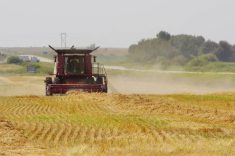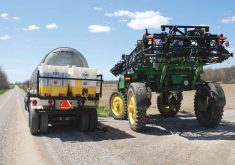As Bayer hints it may soon exit the glyphosate business, the once-hypothetical scenario of farming without Roundup is suddenly on the table.
While imports of other companies’ off-patent brands of glyphosate may buffer the immediate shock, the long-term implications could reshape weed management across the Prairies.
WHY IT MATTERS: As well as being the target of expensive lawsuits in the U.S., glyphosate resistance is percolating amid a number of problem weeds on Canadian farms.
Read Also

Manitoba boosts stake in cereals centre to $23.5 million
Premier Wab Kinew said the additional project funds will help ‘Trump-proof’ the provincial economy.
Hugh Beckie, a former Agriculture and Agri-Food Canada weed scientist, explored this very scenario in 2019. At the time, he was based at the University of Western Australia, so his modelling focused on Australian farming systems. But while the crops may differ, both Australia and Canada depend heavily on glyphosate-based weed control, making many of his findings relevant here.
Beckie’s work laid out not just the impacts of losing glyphosate, but the sweeping, system-wide changes farmers would need to adopt in its absence.
To understand what that shift might look like on the ground, Glacier FarmMedia spoke with Kim Brown, provincial weed extension specialist with Manitoba Agriculture, about the tools, trade-offs and decisions farmers may face if glyphosate were to disappear from the weed control toolbox.
Brown says Canadian farmers have already been working to reduce their reliance on glyphosate due to the rise of herbicide-resistant weeds.
“We’ve already been going down that road where glyphosate for certain weeds just has not been working,” Brown says.
“We’ve had to find alternative methods for weed control.”
That said, a full loss of glyphosate would escalate the challenge considerably, especially given that weed pressure is a constant in Prairie fields.
“There are weed seeds in the soil. The weed seed bank is vast,” she says.
“Every single year there will be weeds.”

That tracks with what Troy LaForge, who farms in the brown soil zone near Cadillac, Sask., about 65 km south of Swift Current, predicted when we asked him to consider what his fields would look like if glyphosate were to someday disappear from the market.
“What we would probably see is a progression in winter annual and perennial weeds, and from that perspective, we may have to change up to some different oilseeds where we can use actives like clopyralid (the Group 4 active in products such as Lontrel and Curtail) and some of the graminicides (Groups 1 and 2) that are more effective on perennial grasses like quackgrass and foxtail barley,” he says.
“We’d have to change to some different crops, and I honestly don’t know what those would be at this moment, but we may have to change because we just don’t have means of keeping weeds under control otherwise.”
Southwestern Saskatchewan is not generous with the rainfall and not typically canola country, but if glyphosate were to go away, “it might mean that we’ve got to start growing canola more continuously to use a product like glufosinate (the Group 10 active in Liberty) for example.”
Brown concurs there are other herbicide options, even in glyphosate-tolerant systems, thanks to stacked traits — but those alternatives likely won’t cover the same broad weed spectrum that glyphosate does.
“We will have alternatives,” she said.
“But it’s going to get a lot more complicated, and it’s definitely going to get more expensive.”
Farmers may also need to revisit herbicide products they aren’t currently using and some they haven’t used in years. Brown said some older chemistries may play a bigger role again, particularly in rotation or in tank mixes.
However, product availability, crop safety and regional fit will be key considerations.
“To me, as a no-tiller, the No. 1 issue is going to be what we replace it with, and at this point, the actives that are registered are going to increase our costs significantly,” LaForge says.
“And it’s probably going to mean that we’ve got to bring back some active ingredients that we haven’t had for a while and just have higher levels of toxicity at the end of the day.”
Losing glyphosate would also push integrated weed management (IWM) to the forefront.
“Those tools have always been there,” Brown says.
“In the past, we haven’t used those tools as effectively as we could. But we’re going to have to now because we won’t have a choice.”
Brown stresses the value of crop competition: adjusting seeding dates, seeding rates, row spacing and cultivar selection all help. But the biggest lever, she says, is crop rotation.
“Crop diversity is probably the single biggest thing we need to do when it comes to weed control.”
Life cycle diversity — mixing annuals and perennials, or at least spring and fall crops — can help break weed cycles and reduce reliance on any single product or practice.
Beckie’s paper indicates how Canadian farmers may have a leg up over their Australian counterparts when it comes to managing glyphosate resistance.
In Western Canada, about 40 per cent of canola acres are planted to herbicide-resistant varieties, but resistance hasn’t taken off the way it has in Australia. That’s largely thanks to the widespread use of glufosinate-tolerant cultivars and more diverse crop rotations.
Still, Beckie warns, losing glyphosate as a pre-harvest option would hit hard in pulse crops, where there are few good alternatives for controlling tough perennial weeds.

Harvest weed seed control (HWSC) is another tool Brown mentioned, and it also played a central role in Beckie’s post-glyphosate scenario. Originally developed in Australia — where herbicide resistance evolved faster and hit harder — HWSC focuses on capturing or destroying weed seeds at harvest to prevent them from replenishing the seed bank.
Beckie’s modelling leaned heavily on this strategy, especially in the absence of effective pre-harvest herbicides.
HWSC has also been gaining traction in Canada and could become more relevant as farmers look for non-chemical ways to keep weed populations in check.
“You want to destroy the weed seeds, or you want to move them, or take them off the field and not let them add to the weed seed bank,” Brown says.
Tillage remains an option, and Brown notes it’s something most farms already have the equipment to do — but bringing tillage back as a primary weed control tool comes with consequences.
Brown points out that glyphosate was instrumental in the widespread adoption of minimum- or zero-till systems, and that if it’s no longer available, it could set things back significantly.
“There’s going to be many negative consequences with that,” she says, “including soil degradation, increased greenhouse gases and even just fuel consumption.”
Hence at LaForge’s farm, for example, tillage is just not an option.
“If we have to go back to tillage in this part of the world, we (would) probably decrease our yields instantly by 30 to 40 per cent,” given the amount of soil moisture that would be lost in the process, he says.
The availability of glyphosate has increased the diversity and productivity of the farm’s rotations and “created a whole new level of soil conservation in this area.”
There’s some hope on the horizon.
Brown points to emerging technologies such as laser weeding, electrocution, steam weeding and the potential for new herbicides or non-traditional weed control products. Much of this innovation, she said, is being driven by the urgency of the current situation.
“There’s a lot of research being done because of the very situation that we’re in right now,” she says.
Extension specialists such as Brown will play a key role in helping farmers adjust. She said the core message around integrated weed management isn’t changing, but the urgency and scope of that message are growing.
“We’re just going to have to get a lot more educated on some of these products that are out there that we need to be using,” she says.
“We have to raise that level of comfort, because that will be new territory for many farmers.” — With files from Dave Bedard
















